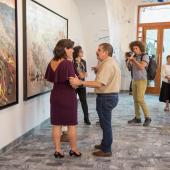Luces, 1ra exposición
Description:
In Kant's practical philosophy, as in life, the maxim is a sort of rule or ordering principle that reaches relevance as a proposal for behavioral ordering. Those norms that day by day have become valid, constitute systems of values that work in different areas. Those related to existence itself, ethics, morals and trades, among some of them.
Following the course of Kantian thought, two focuses of interest can be identified, which this exhibition evokes with a reflexive intention. On the one hand, the human behaviour capable of being (or not) modelled according to certain precepts and, on the other hand, the norms that occur in the territory of art and of the praxis itself within this field. Areas that can be forged, from the logics of thought and action, and propitiate a differentiating character both in individuals and in what results from creation.
The maxims are those lights that illuminate ways of living and founding, of proceeding and acting, of exchanging and coexisting. Possible routes to forge worlds, guides to proceed and contribute to improving the context in which each person lives. From them, it is perhaps possible to foreshadow a social fabric of new utopias where they are fuel and action; transforming energy.
Seen in this way, they can also be assessed as an indispensable circumstance for artistic growths such as those that concur here. They support that construction that is the "landscape" in the poetics of Rafael Villares, creating again and again environments committed to natural environments, as a result of his interest in making us more aware of what surrounds us. An intention that is discovered in the intervention of spaces, installations, objects, drawings, paintings and photographs that go beyond simple contemplation, appealing to the sensory and generating new and also multiple connections and possibilities sense.
Juan Suarez Blanco, for his part, maintains his rigour based on his taste for narration and the simulation that has been characteristic of his work, now fulfilling the dream -through abstraction- of recreating tears, cuts, burns, structuring sites in the manner of a novel via crucis, while experimenting with multiple surfaces and with poor recycled materials. From the virtuous proceeding with the different components, emerges that light (mystical and also animistic reference) capable of making us pay attention to the evolution of time, to the transfiguration of matter and to the eternal struggle between good and evil.
Appealing to the contrast of black and white and the symbolic value of the elements represented, Jorge López Pardo perpetuates the minimalist ancestry of his drawing. His images recreate spectra capable of opening a disturbing gap within that dazzling luminosity that has become characteristic in his recent symbolic production. Synthesis and excellence accompany that freedom with which the artist manifests himself in his poetic (philosophical) exercises, with respect to the individual and society, sublimating absences and loneliness.
Douglas Pérez's questioning painting remains open to the revision of history, insofar as it has instrumented the deconstruction of that national narrative that is sustained as truth. His singular performance -qualified by many as neo-historicist- gives continuity, through diverse series, to his approaches of ethnographic value, to his particular recovery of the tradition of humor, as well as to the convergence of popular culture and the so-called "high culture", in that gigantic pastiche that is his work, where the space that occupied the ingenuity is today a city of absurd fantasy.
In another sense, but equally radiant, are the graphic gestures of Irving Vera. His works constitute an awakening of the poetic image and are improvisations born from his own life experiences. His drawings have an important connection with other works and authors of the visual arts and literature that he has as references. In his bet of conceptual lineage, the text is a catalyst of senses, while his lyricism touches the spectator in a suggestive way from a sensibility that seeks those images capable today of making us vibrate.
Finding connections between the systems that modeled these discourses (and their authors) and those that must guide a space for art, leads to this birth.
Caridad Blanco de la Cruz
In this video you can see moments of Ligths, first exhibition of Maxima Gallery.







